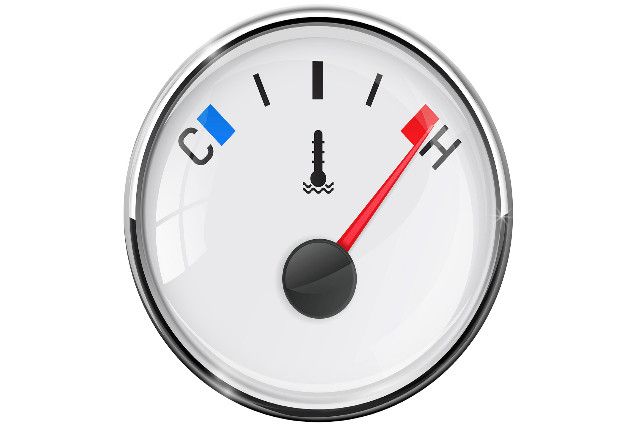
www.buildingsandcities.org/insights/commentaries/lomas-overheating-in-new-homes.html
Overheating in New Homes: A New Design Tool

Kevin Lomas explains why the risk of overheating in homes is an increasing problem in the UK and elsewhere - in both existing buildings but also for the construction of new dwellings.
To address this public health problem, a ground-breaking new tool has been developed and launched to assist designers, planners and clients to identify and reduce the risk of summer overheating in dwellings. A key benefit is its simplicity, early application in the design process, potential to inform design strategies and the provision of supporting background information and guidance. Further uses are envisaged, for example to identifying properties and rooms at risk of overheating - for public health compliance as well as education and training. Although this tool was developed for use primarily in the UK, it should inspire others around the world to take similar action.
Summertime overheating in UK dwellings (and many other places worldwide) is widespread and increasing. The UK government's Environmental Audit Committee (HMG, 2018a) estimates that around 20% of UK homes overheat. This affects people's health and well-being especially the young and elderly. In the European heatwave of 2003, there were 2200 heat-related deaths in the UK in just 10 days and an estimated additional 15,000+ premature deaths across Europe. As the country warms, heat waves will become longer, more frequent, and more intense. The Committee estimates that 'there will be 7,000 heat-related deaths every year in the UK by 2050 if the Government does not take action'. Overheating also has more subtle effects: it leads to degraded sleep which impacts on people's health and wellbeing. Given the imperative not to increase energy demand in buildings, the introduction of air conditioning in temperate climates must be avoided. But this raises some important questions, what actions should be taken, by whom, when and where?
The overheating problem is being compounded as we continue to build new homes that will overheat (Lomas and Porritt, 2017); and this may be exacerbated by the UK's Industrial Strategy. As one of its three strategic areas, the Construction Sector Challenge, is pushing 'Offsite manufacturing technologies' …. 'to minimise the wastage, inefficiencies and delays' …. 'speeding up construction and reducing disruption' (HMG, 2019). This move to so-called 'modern methods of construction', an epithet that might equally well have been used for the pre-fabrication/industrialisation/system-build initiatives of the past, can bring with it many unintended consequences. Stuart Green's commentary in Buildings and Cities (Green, 2019) identifies undesirable consequences for the economy, construction industry, local employment and house buyers. The concern here is the added risk of summertime overheating that comes with well-insulated, thermally lightweight, low-cost construction methods (e.g. Lomas and Porritt, 2017; HMG, 2018b); especially when used to build flats and apartments (e.g. ZCH, 2015).
Prevention by regulation is one approach, and regulatory change has been called for by the Committee on Climate Change (CCC, 2015; HMG, 2018b). However, changes to building regulations take a long time and firm intent is often weakened in the consultative process. Furthermore, regulatory enforcement can be unreliable, especially in new and complex matters such as overheating. Advice and guidance can help (e.g. ZCH, 2015; NHBC Foundation, 2012a, 2012b) but such advice is often qualitative, and it is difficult for designers and construction companies to know exactly what is needed, when and how. Neither is there a solid foundation on which to anchor and defend decisions, for example in the face of cost cutting, so-called value engineering, and other necessary design compromises. Modelling can help to predict the likelihood of overheating, but the SAP Appendix P method is unreliable (BRE, 2013) and dynamic thermal modelling is time consuming and too costly for housebuilders.
Fortunately, the Good Homes Alliance (GHA) has stepped up to the challenge by producing its Early Stage Overheating Risk Tool (GHA, 2019). The tool, which is free and open access, adopts a scoring approach similar to the credit-based system of, for example, BREEAM (BRE, 2016). The tool lists the features that tend to increase the likelihood of overheating (in red, negative) and the features that tend to reduce the risk (in green, positive). The features listed are all well-known factors, but the benefit is seeing them clearly listed on a single sheet of paper. The crucial additional component is that each feature (red or green) has an associated score. What matters here is the relative magnitude of the positive and negative scores. Thus, for example, a glazing ratio on a sun-facing façade of over 65% scores +12, but the shading thereof, even fully (which might not be structurally possible), scores -6. The clear message being, oversized glazing cannot be ameliorated by shading (Fig. 1).

Figure 1: Excerpt from the Good Homes Alliance tool for identifying and mitigating overheating risk.
Scores, both positive and negative, are provided for geography and local context (UK region, urban heat island or rural); site characteristics (do noise pollution or security concerns act as barriers to window opening, or do blue/green infrastructure or pale surfaces cool the surroundings); design (are the homes flats? with community heating? Thermally lightweight? Or have low ceilings?); and finally, solar gain and ventilation (window-to-wall ratios, cross - or single sided ventilation, designed (self) shading, and window opening areas). The total net score from the 8 (positive) risk factors and 7 (negative) mitigating factors, is then determined, and a traffic light system used to indicate the overheating risk, 12 or more and the risk is high, 8 or less and the risk is low.
It is the relative scores and simplicity of the tool that are so appealing for a design team. It gives designers and others a clear vocabulary of factors that affect overheating and guidance on their interactions. For the first time, it provides them with a clear and simple framework within which to think about this complex problem. The scores show what is more, or less, important and so where to focus attention. One may readily imagine a team debating the design options with everyone equally able to understand the relative consequences of the decisions made. Is design option A better than option B, and by how much? If we replace feature X by feature Y, why how much will the overheating risk change?
For proponents of blue/green infrastructure, the low mitigation scores might be disappointing, likewise for the provision on night-ventilated thermal mass. Indeed, a bad design on a noisy, polluted site cannot be 'retrieved' even if all possible mitigations measures could be implemented.
Behind each section of the overheating risk tool there is the guidance. This explains why an issue is important, how to decide on a score, how to mitigate the overheating risk (i.e. reduce positive scores). It explains for example how to improve window designs, implement effective shading or provide secure ventilation. The associated images are very helpful. If there is one small criticism it is that this part of the tool is under-developed. This guidance and exemplar section has a valuable educational role to play, and one could readily see it expanding into a fully-fledged overheating design guide, somewhat like the passive solar design guides of the past (Yannas, 1994).
The tool might have wider applications than its current billing as an early stage design tool for new dwellings suggests. One might, for example, imagine it as an aid to social housing providers, local councils or private landlords. They could triage their existing building stocks to pinpoint spaces and buildings at risk of overheating. It would help them to critique any proposed new builds they intend to commission. One also wonders if it could also assist inspectors to operate the 'excess heat' section of the Housing Health and Safety Rating System (HHSRS) more effectively (DCLG, 2006). Presumptions built into the tool, for example about the insulation standard of the dwelling and other features might have to change, but the overall principle could have utility. As an academic, I can also see the tool assisting in the training of architecture students.
Overheating is now recognised as a serious risk in new homes and one that climate change and the UK Government's current construction strategy will make worse. The GHA is to be highly commended for their initiative by providing their clear and concise overheating design tool. This is a good example of how the research community can effectively underpin and support practice. The robust body of knowledge about overheating brought this issue to the attention of government and civil society. It is a great credit to GHA and similar organisations that they had positive engagement with this. Although this tool was developed for use primarily in the UK, it is hoped that it will inspire others around the world to take similar actions.
References
BRE (2013) Energy Follow-up Survey, 2011: Report 7: Thermal comfort and overheating. UK Building Research Establishment for the Department of Energy and Climate Change, Section 3.2.5, BRE Report No. 287472, 31pp. https://assets.publishing.service.gov.uk/government/uploads/system/uploads/attachment_data/file/414600/7_Thermal_comfort.pdf
BRE (2016) BREEAM Refurbishment Domestic Buildings, Technical Manual: Version: SD5077 - Issue:2.2 - Issue Date:29/02/2016. Watford: Building Research Establishment.
CCC (2015) Reducing emissions and preparing for climate change: 2015 Progress Report to Parliament Summary and recommendation, Presented to Parliament pursuant to sections 36 and 59 of the Climate Change Act 2008. London: Committee on Climate Change. https://www.theccc.org.uk/publication/reducing-emissions-and-preparing-for-climate-change-2015-progress-report-to-parliament/
DCLG (2006) Housing Health and Safety Rating System Guidance for Landlords and Property Related Professionals. London: Department for Communities and Local Government. ISBN 9781851128563. https://www.gov.uk/government/publications/housing-health-and-safety-rating-system-guidance-for-landlords-and-property-related-professionals
GHA (2019) Overheating in New Homes: Tool and guidance for identifying and mitigating early stage overheating risks in new homes. London: Good Homes Alliance. https://goodhomes.org.uk/wp-content/uploads/2019/07/GHA-Overheating-in-New-Homes-Tool-and-Guidance.pdf
Green, S. (2019) Modern Methods of Construction: Unintended Consequences, Buildings and Cities, [commentary]. https://www.buildingsandcities.org/insights/commentaries/modern-methods-of-construction.html
HMG (2018a) Heatwaves: adapting to climate change, Environmental Audit Committee. London: Her Majesties Government, 26 July. https://publications.parliament.uk/pa/cm201719/cmselect/cmenvaud/826/82603.htm
HMG (2018b) Ministers dragging their feet on action to protect people from heatwaves, Commons Select Committee. London: Her Majesties Government, 24 October. https://www.parliament.uk/business/committees/committees-a-z/commons-select/environmental-audit-committee/news-parliament-2017/heatwaves-government-response-published-17-19/
HMG (2019) Policy Paper: Construction Sector Deal. London: Her Majesties Government, July. [Available at: https://www.gov.uk/government/publications/construction-sector-deal/construction-sector-deal]
Lomas KJ and Porritt SM (2017) Overheating in buildings: lessons from research. Building Research & Information, 45(1-2), pp 1-18. ISSN 0961-3218. Doi:10.1080/09613218.2017.1256136.
NHBC Foundation (2012a) Understanding overheating - where to start: an introduction for house builders and designers (NF44). Milton Keynes: NHBC Foundation. https://www.nhbcfoundation.org/publication/understanding-overheating-where-to-start/
NHBC Foundation (2012b) Overheating in new homes: a review of the evidence (NF46). Milton Keynes: NHBC Foundation. https://www.nhbcfoundation.org/publication/overheating-in-new-homes/
Yannas S (1994) Solar Energy in Housing Design, Vol 1: Principles, Objectives, Guidelines. London: Architectural Association (on behalf of the Dept of Trade and Industry). ISBN 1-870-890-36-1, pp 30-37, pp 49-99.
ZCH (2015) Overheating in Homes the Big Picture, Full Report. Zero Carbon Hub. [No longer available online.]
All references accessed 23.10.2019.
Latest Peer-Reviewed Journal Content
Designing for pro-environmental behaviour change: the aspiration–reality gap
J Simpson & J Uttley
Lifetimes of demolished buildings in US and European cities
J Berglund-Brown, I Dobie, J Hewitt, C De Wolf & J Ochsendorf
Expanding the framework of urban living labs using grassroots methods
T Ahmed, I Delsante & L Migliavacca
Youth engagement in urban living labs: tools, methods and pedagogies
N Charalambous, C Panayi, C Mady, T Augustinčić & D Berc
Co-creating urban transformation: a stakeholder analysis for Germany’s heat transition
P Heger, C Bieber, M Hendawy & A Shooshtari
Placemaking living lab: creating resilient social and spatial infrastructures
M Dodd, N Madabhushi & R Lees
Church pipe organs: historical tuning records as indoor environmental evidence
B Bingley, A Knight & Y Xing
A framework for 1.5°C-aligned GHG budgets in architecture
G Betti, I Spaar, D Bachmann, A Jerosch-Herold, E Kühner, R Yang, K Avhad & S Sinning
Net zero retrofit of the building stock [editorial]
D Godoy-Shimizu & P Steadman
Co-learning in living labs: nurturing civic agency and resilience
A Belfield
The importance of multi-roles and code-switching in living labs
H Noller & A Tarik
Researchers’ shifting roles in living labs for knowledge co-production
C-C Dobre & G Faldi
Increasing civic resilience in urban living labs: city authorities’ roles
E Alatalo, M Laine & M Kyrönviita
Co-curation as civic practice in community engagement
Z Li, M Sunikka-Blank, R Purohit & F Samuel
Preserving buildings: emission reductions from circular economy strategies in Austria
N Alaux, V Kulmer, J Vogel & A Passer
Urban living labs: relationality between institutions and local circularity
P Palo, M Adelfio, J Lundin & E Brandão
Living labs: epistemic modelling, temporariness and land value
J Clossick, T Khonsari & U Steven
Co-creating interventions to prevent mosquito-borne disease transmission in hospitals
O Sloan Wood, E Lupenza, D M Agnello, J B Knudsen, M Msellem, K L Schiøler & F Saleh
Circularity at the neighbourhood scale: co-creative living lab lessons
J Honsa, A Versele, T Van de Kerckhove & C Piccardo
Positive energy districts and energy communities: how living labs create value
E Malakhatka, O Shafqat, A Sandoff & L Thuvander
Built environment governance and professionalism: the end of laissez-faire (again)
S Foxell
Co-creating justice in housing energy transitions through energy living labs
D Ricci, C Leiwakabessy, S van Wieringen, P de Koning & T Konstantinou
HVAC characterisation of existing Canadian buildings for decarbonisation retrofit identification
J Adebisi & J J McArthur
Simulation and the building performance gap [editorial]
M Donn
Developing criteria for effective building-sector commitments in nationally determined contributions
P Graham, K McFarlane & M Taheri
Join Our Community

The most important part of any journal is our people – readers, authors, reviewers, editorial board members and editors. You are cordially invited to join our community by joining our mailing list. We send out occasional emails about the journal – calls for papers, special issues, events and more.
We will not share your email with third parties. Read more



Latest Commentaries
COP30 Report
Matti Kuittinen (Aalto University) reflects on his experience of attending the 2025 UN Conference of the Parties in Belém, Brazil. The roadmaps and commitments failed to deliver the objectives of the 2025 Paris Agreement. However, 2 countries - Japan and Senegal - announced they are creating roadmaps to decarbonise their buildings. An international group of government ministers put housing on the agenda - specifying the need for reduced carbon and energy use along with affordability, quality and climate resilience.
Building-Related Research: New Context, New Challenges
Raymond J. Cole (University of British Columbia) reflects on the key challenges raised in the 34 commissioned essays for Buildings & Cities 5th anniversary. Not only are key research issues identified, but the consequences of changing contexts for conducting research and tailoring its influence on society are highlighted as key areas of action.